I had traveled over six hours through Belize’s bumpy, unmarked jungle roads to meet a man whose name was on everyone’s lips. I’d seen his sun-bleached photo plastered on clapboard shopfronts, I’d heard his name as I queued for my daily fry jack fix, I’d even read about him between the pages of my Lonely Planet guide.
This man was Austin Rodriguez, Central America’s most famous Garifuna drum maker. With over 50 years of drum-making experience, Austin is known throughout Belize—and the world—for being one of the most skillful drum makers in history. What I found as I approached his thatched, wall-less seafront workshop, however, wasn’t what I had been expecting. Swinging in his hammock to the sound of the ocean, the legendary self-taught drum maker was indeed there but now, at 89-years-old, it wasn’t Austin Rodriguez behind the chainsaw, it was his daughter, Daytha Rodriguez.
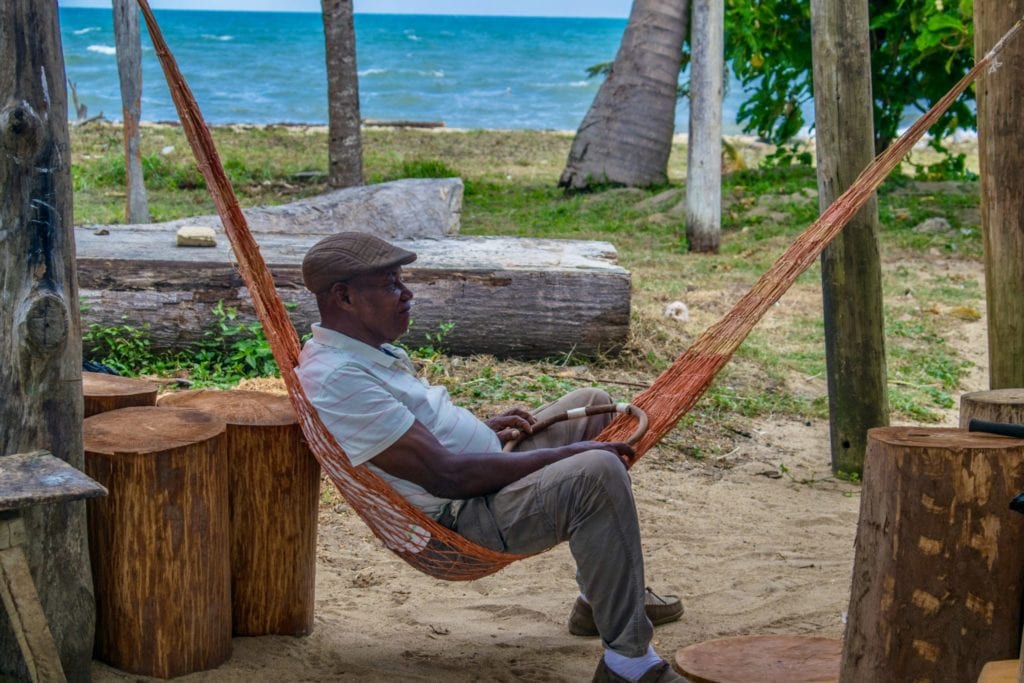
The Garifuna—today considered one’s of Belize’s predominant cultures—are descendants of Carib, Arawak, and West Africans. This mixed heritage is attributed to the sinking of a slave ship destined for the New World in 1635, where a group of West Africans escaped and swam to the island of St.Vincent. Here, they were met by Arawak and Carib islanders, who, over centuries of cohabitation and interracial marriage, would soon become one people with a very distinct culture: the Garinagu (plural for Garifuna). Escaping further persecution from European slave merchants and colonialists, by 1832 the Garinagu would flee the island of St.Vincent and land on the shores of Belize (as well as Honduras and Guatemala); a white-sand, blue-sea paradise that they would call home for the next 200 years.
It was during this time that many of the Garifuna traditions that we see today, including the important role of drum-making and playing, were formed. Drums—the beating heart of Garifuna culture since West Africans first arrived on the shores of St.Vincent—today act as the strongest connection that modern Garinagu have to their African, Carib, and Arawak ancestry. Steeped in symbolism, the distinct sounds of the Primero (lead) and Segunda (bass) drums are not only at the heart of every celebration, ritual, and ceremony, but they’re also the primary vehicle for Garifuna storytelling, a part of the culture, along with the Garifuna language, that UNESCO warned was in danger of being lost forever back in 2008. The honor of keeping this important facet of Garifuna culture alive has been, for the best part of 400 years, a privilege reserved exclusively for men. Now, in the small, forgotten town of Dangriga, this may—finally—be about to change.
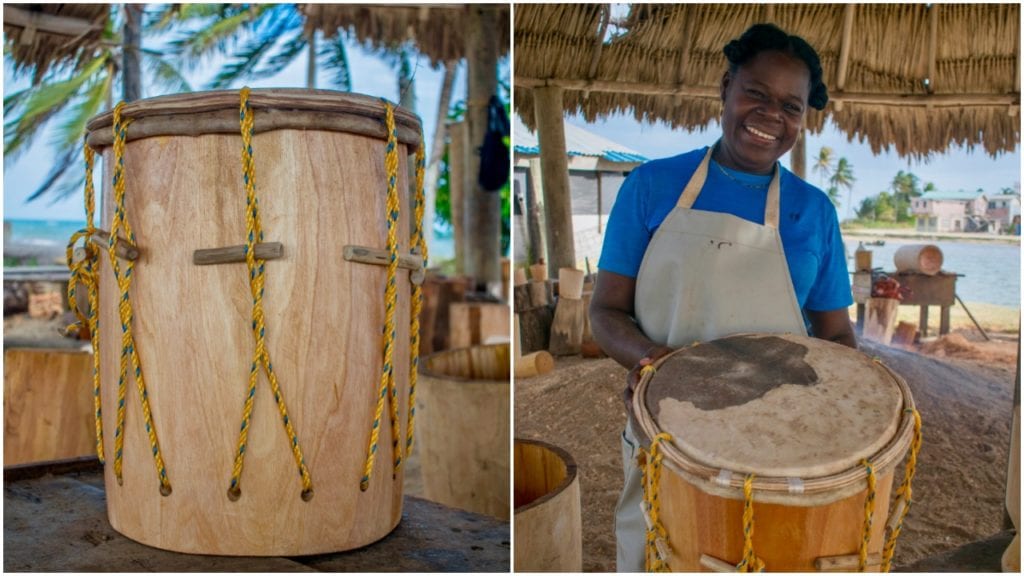
I noticed her presence immediately. Tall and strong, Daytha was sending thousands of wood chippings flying across the workshop as she effortlessly sliced through thick barrels of mahogany and cedar. No one had noticed that I was standing in the workshop, so I approached Austin in his hammock and asked if I could speak to him about the drum-making process. “I don’t make the drums anymore”, he replied pointing over to the woman by the chainsaw, “my daughter, Daytha, does.” A little disappointed at Austin’s short reply (I had, after all, traveled all this way to meet the legend himself), I shuffled over awkwardly to where Daytha was working. Once she saw me, she smiled warmly, wiped the sawdust from her face, and switched off the chainsaw.
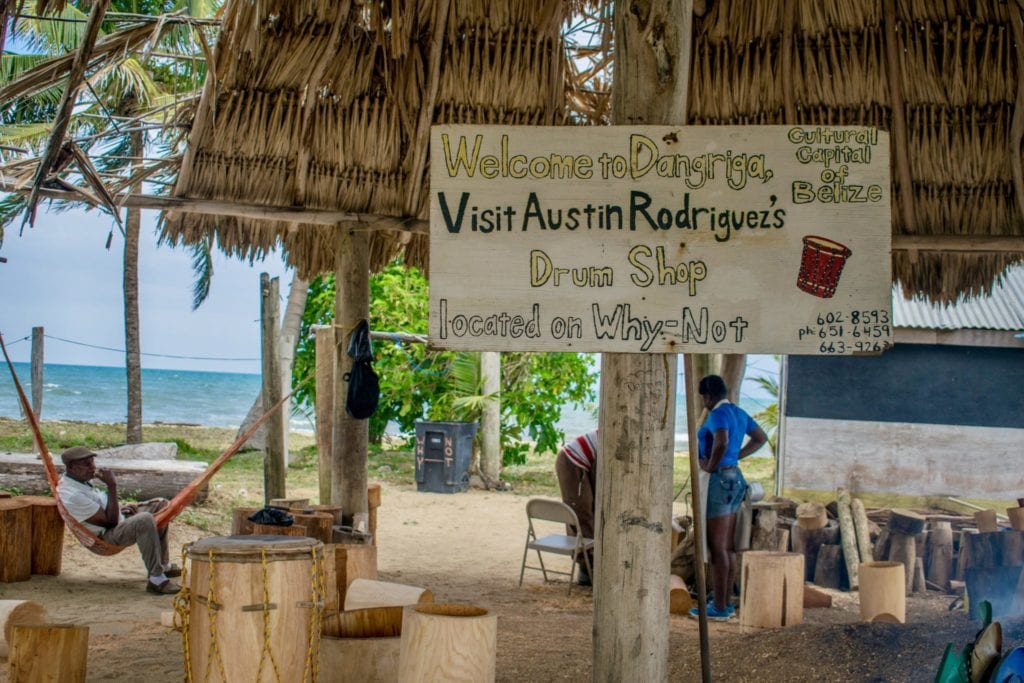
Daytha—now in her 40s—grew up in her father’s workshop on Dangriga’s “Why Not” island in Southern Belize. Every day after class, she would jump off the beat-up yellow school bus and rush to his side to watch him work on his drums. “I wanted to be like my dad,” Daytha said as she searched the woodchip-covered floor for a piece of animal hide. “I liked that he didn’t have a boss, you know? He could work how and when he wanted; he was free. I wanted a life like that.”
Despite her many pleas, Daytha’s father would never let her assist him. “Drum-making isn’t for little girls, Daytha,” her father would say. When Daytha turned 15, however (apparently impressed that she was still so interested in his trade), Austin finally let his daughter help him sand down and stretch the skin over the drums. “Sand that drum until you can smell garlic, my father would tell me,” Daytha said in between fits of laughter as the palm trees swayed in the wind behind her. “I would sit there all afternoon sanding that drum, you know. I would sit there sanding that drum until my hands were blistered!” Seeing my confused face, she added with a smile, “of course, I never smelt the garlic. My father just wanted me to sand the drum to perfection.”
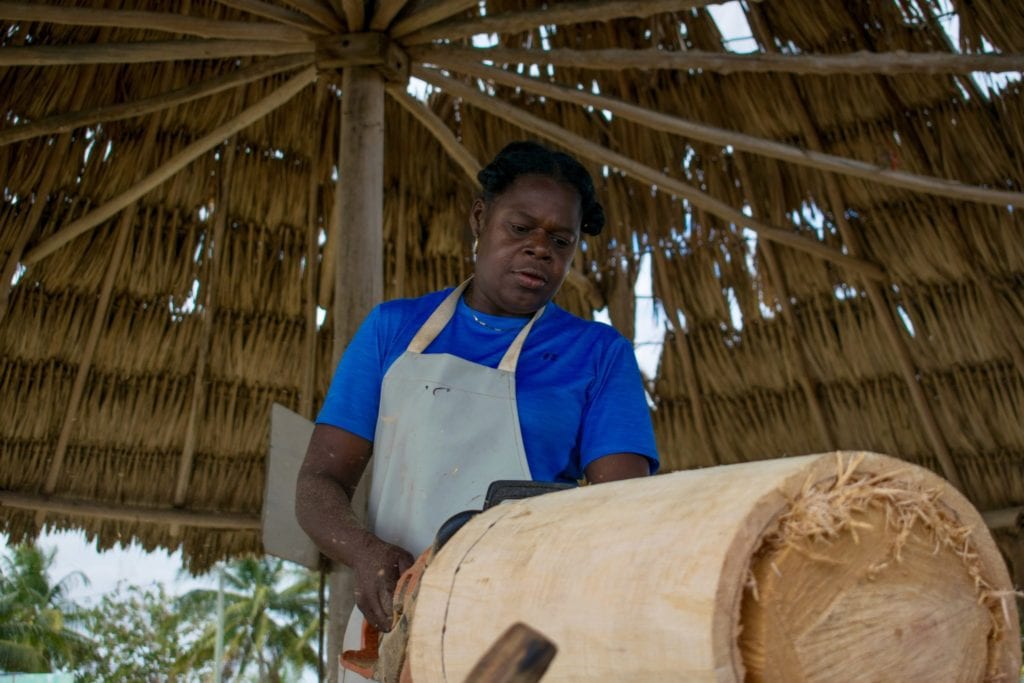
Fifteen-year-old Daytha may have been an expert in sanding, but–considered too dangerous and too physical a job for a woman–she still wasn’t allowed to handle the chainsaw. That all changed, however, when an American tourist arrived at the workshop. Having heard about Austin’s talents, he had traveled to Dangriga just to buy one of his famous drums. But when the visitor saw Austin’s young daughter expertly sanding a drum in the corner, he said to Daytha: “will you make me one?”
“I was so excited,” Daytha told me with a wide smile on her face. “For the first time ever, someone was asking ME to make them a drum! I had to get it done for him the following day before he left Dangriga, but the problem was I wasn’t allowed to use the chainsaw, so I had to ask my father.” That day, standing in the very same spot we were in right now, Daytha would ask Austin repeatedly to cut the drum out for her, but, without so much as looking up from his drum, he would simply reply, “I’m busy.” “I asked him again and again,” Daytha chuckled looking over at Austin swinging in his hammock, “but he wouldn’t do it! He just kept saying “I’m busy! I’m busy!”
Out of frustration, Daytha picked up the chainsaw and started plowing into the huge piece of mahogany herself, doing what, after years of watching and listening, her hands told her to do. “I don’t know how I did it, but I did,” recalled Daytha. “I looked down at the drum, and the drum was good!”
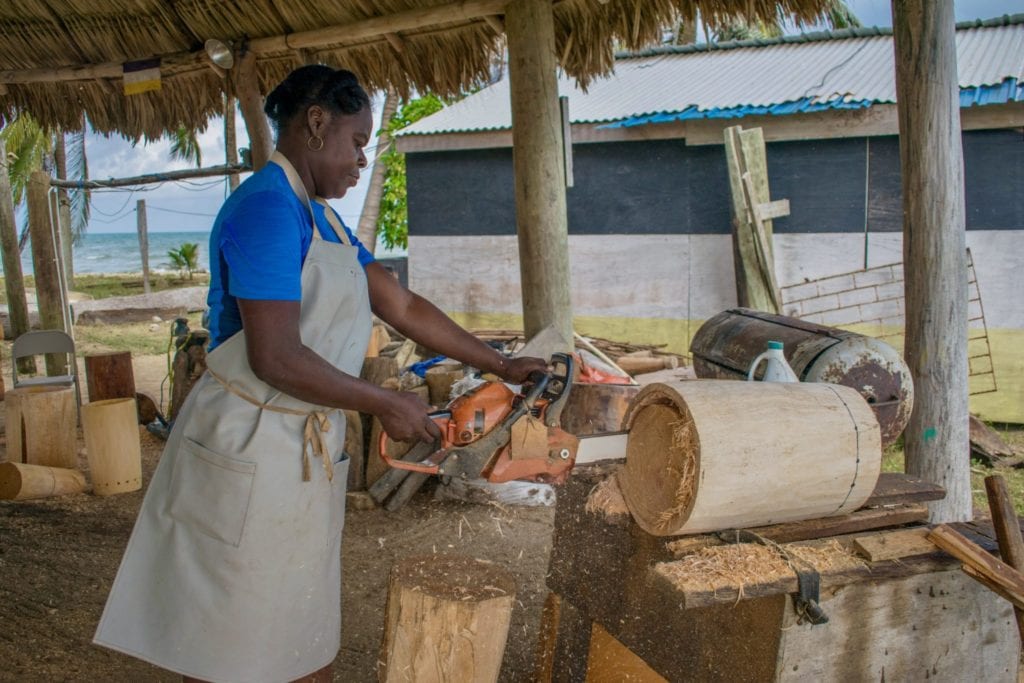
When she showed her dad, Austin smiled. “I knew you could do it, Daytha. If I’d said yes, you would have asked me to do it tomorrow, and again the next day. And again the next.” Almost three decades later, Daytha—with the help of her sister and son—now produces the vast majority of Belize’s, Honduras and Guatemala’s Garifuna drums, and has exported as far as the US, Canada, and even Europe.
While it is her father’s name that still remains on every Belizean storefront and international guidebook, the truth is that it is Daytha—Belize’s first female master drum maker—who has been quietly keeping the Garifuna drum tradition alive. This is a story of a woman who is striving to maintain a famous family legacy while carving the way for a new Garifuna era: one where strong, courageous, and determined women play a far more central role.

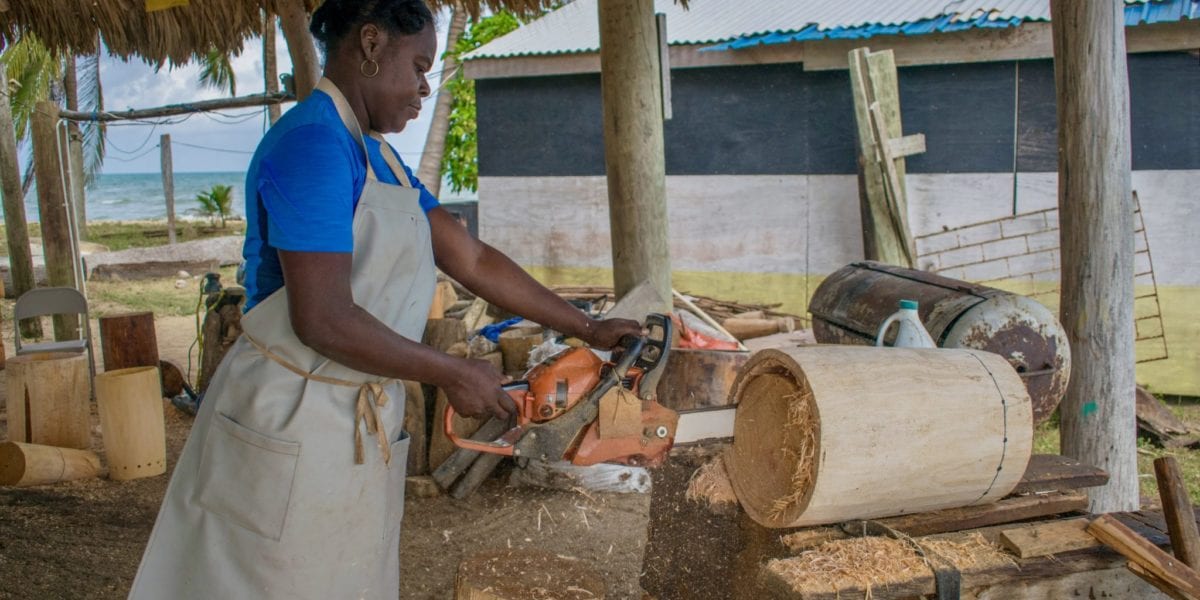

Thank you for writing this article. You manage to capture what is the essence of Garifuna. This will assist in a larger exposure to my often misunderstood culture. The picture that you capture showing the storefront shows that Dangriga is the cultural capital of Belize. This designation has not yet yielded any benefits to my home town. We continue to be marginalized in Belize.
Awesome 👍 thanks for sharing this with me and I will send it to others 👍👌💯🤭💃👁️
I am an anthropologist who has visited the Garinagu several times and taught about them in my course, Cultures of the African Diaspora. I am also a drummer and took home a set of Mr. Rodriguez’s drums! Your story about the Garinagu is excellent, except you left out a very important historical element: at one point the British were fighting a war with the Garinagu on St. Vincent. They defeated the Garinagu and exiled a number of them to Roatan, a small island off Honduras (today very popular with tourists) there is a statue of their military leader. Chatoyer, on Roatan. Lacking resources, many Garinagu were dying so they began migrating to Honduras, Nicaragua and Belize. The majority are now in Honduras. There is still a population on St. Vincent and neighboring Islands. Again, you did an excellent job but I wanted to clarify the Garinagu history.
thanks so much. this needed to be said. also we did not “flee” but were expelled from our home at Yurumein St Vincent
Good job Jessica with that piece you wrote about Daytha Rodriguez and her drum making abilities. I went through your experience. Travelled from the USA to my hometown Dangriga, expecting to make my drum orders with Mr. Rodriguez, but met Daytha instead. After the masterful job she did, what can I say, I’m sold! Thanks again for your well-written contribution to humanity.
I found this very interesting. I see the comparison with Native Americans ceremonial drums. Quite interesting. I think there’s more reason as to why a woman is not allowed to make a drum. That part wasn’t capture I see in your article.
Thank you Bill – that really means a lot. I unfortunately heard many of the same frustrations that you voice from several people in Dangriga. It seems that the Belizean government will have to do a lot more than give out fancy titles and put up signs if they are to truly benefit the community here. I hope my article will at least encourage more visitors to venture further South and get to know the many wonderful artisans and musician in this region.
Thank you for your very informative response, Tanya! My article was more focused on Daytha’s personal story , so I was very light on the historical part (I gave a brief overview in this case to give a little bit of context to any readers who are new to the subject, but wanted the story to progress as quickly as possible to Daytha and what it means to be a Garifuna woman today). But you are right, there is definitely a whole article to be written on the long – and sometimes quite complex – history of the Garifuna people. Thank you for clarifying!
Thank you so much, Ezekiel. I’m glad you enjoyed the piece, especially as someone who is from Dangriga. I hope you enjoy your new drum – they are truly one-of-a-kind!
Thanks for your comment, Darlin p! That is very interesting. Perhaps there are more underlying reasons as to why women historically haven’t played a role in drum-making, but I was recounting the story as Daytha had experienced it. In this case, the reason why she had never picked up a chainsaw until she was 15 was because her father regarded it as a highly physical job (i.e a man’s job). However, Daytha proved to her father that a woman too – even a 15-year-old girl – can have the physical strength to create a world-class Garifuna drum.
This was a good read and the subsequent comments from other readers are right on point. I am proud of Daytha and her family for the work they do in keeping our culture alive. If you ever visit us again, be sure to search for some Master Drummers. Joshua Arana at the National Institute of Culture and History will be able to assist…….this will complete your story.
Great article! I spend quite a bit of time doing work in Dangriga and the Stann Creek district. I have had the pleasure of spending some time with Austin and Daytha. Wonderful people who do incredible work. There are things about the Garifuna culture that remain vibrant in Belize because of the pride many of the people have for their history. Food and music of the Garifuna are easily found in Dangriga. Thanks for sharing the story with us!
Mr. Austin Rodriguez was my next door neighbor growing up. When I was a child around the age of nine , my friends from the neighborhood would go to his house to help carve 🛶 canoes and mata ( a tool used for beating plantains). He is a very patient and humble man who loves children and always has a way to make everyone laugh. His late wife who everyone new as Mrs. Shata and their children are all as pleasant. I still go visit him when I’m in Dangriga and it amazes me that his memory is all in tact. He always refer to things that happened sixty years ago for example a whipping that I got from my father for being mischievous. I would to thank you personally for this exposure. It’s fitting and an honor that is well deserved for mr. Austin Rodriguez. I’m happy that someone did it now that he is still alive and did wait until his absence from earth. Thank you, Thank you and Thank you.
Is her sister no longer involved in the drum making?
Nori still makes drums as well but does not do so at Why Not. She has her own operation at her home.
Thanks for this piece Jessica Vincent and Unearth Women. Daytha and Yaw Austin, in fact their family on a whole, deserve this exposure and recognition for their tremendous work in Garifuna cultural preservation. I, myself, was very happy to have gotten a pair of drums last year that Yaw Austin made and got the chance also to see Daytha in action since she now is the primary drum-maker in the family. While the Garifuna story definitely needs to be re-written from the perspective of the Garinagu, this article certainly recognizes and highlights our resilience as a people. Continue to seek out and tell these powerful stories of women breaking barriers.
Hi Jessica! you are awesome for writing this article about Daytha and Austin. I was a Peace Corps volunteer between 1991-1993 in Dangriga and lived in the house next door to the Rodriguez family. They were (and still are) an amazing family. Antie was Daytha’s mom. She organized other Garifuna women to make cassava bread, which is a traditional Garifuna food. Back then, Austin worked throughout the night to make drums. So happy to see that Daytha has taken over for Austin. She is exactly the same leader that her mom was.
am Charles from Germany and I do love to have a contact with Belize and Hondura beautiful women for long time relationship. Hope to hear from you soon and God Bless you.
We just met with Daytha today. Her smile is so infectious. She explained the process and tuned a drum to play a bit. Truly an amazing experience and she is an inspiration. She continues the tradition her father passed on to her and she’s training the young drum makers still. Thanks for a memorable experience